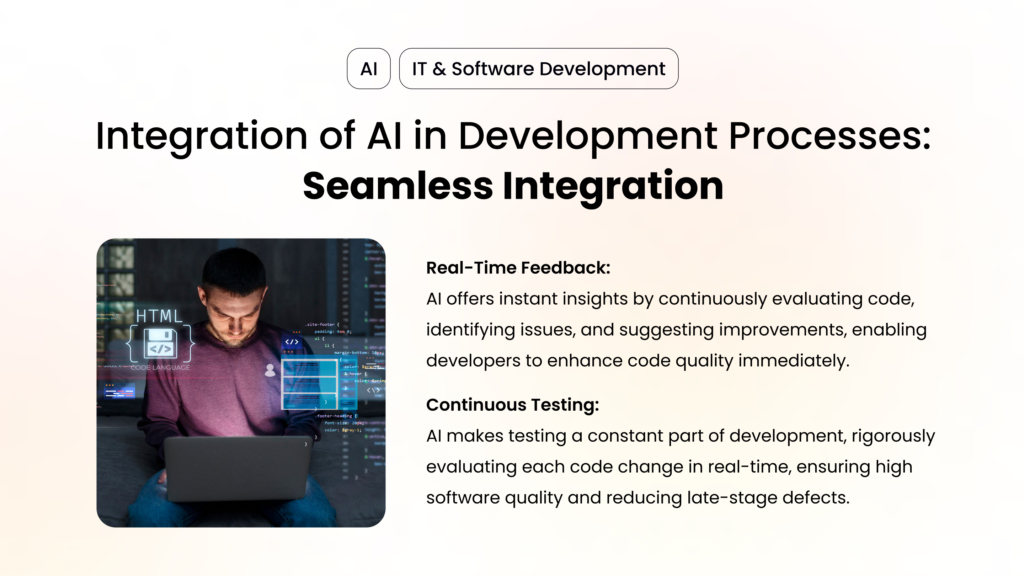The software development landscape is evolving at an unprecedented pace, driven by the relentless advancements in artificial intelligence (AI). For software developers and IT managers, integrating AI into the software development lifecycle is no longer a luxury but a necessity. This transformation promises not only enhanced efficiency and productivity but also the ability to stay ahead of the competition.
In this comprehensive guide, we will explore the AI development lifecycle, uncover the myriad benefits it offers, and provide a step-by-step approach to effectively implementing AI in your development process. This article will equip you with the knowledge and insights needed to harness the full potential of AI.
Understanding the AI Development Lifecycle
The AI development lifecycle is a structured framework that guides the creation of AI software from concept to deployment. This systematic approach ensures seamless collaboration among project managers, stakeholders, developers, and designers, leading to high-quality AI solutions.
By following this lifecycle, teams can streamline their workflows, reduce risks, and enhance the overall quality of their AI projects. Let’s break down each stage of the AI development lifecycle to understand its significance.
Benefits of Implementing the AI Lifecycle
Enhanced Decision-Making
AI-powered solutions enable businesses to make data-driven decisions with unprecedented accuracy. By understanding the problem at hand and aligning AI models with business goals, organizations can achieve better outcomes and drive growth.
For example, a retail company can use AI to analyze customer purchasing patterns and optimize inventory management, resulting in reduced costs and increased sales. This level of precision in decision-making is only possible with a well-implemented AI lifecycle.
Efficient Resource Utilization
Structured project management within the AI lifecycle ensures that resources are utilized optimally. From data acquisition to model deployment, every step is carefully planned to minimize waste and maximize efficiency.
Consider a healthcare provider implementing AI for patient diagnosis. By efficiently managing data collection, model training, and deployment, the provider can deliver accurate diagnoses faster, improving patient care and reducing operational costs.
Reliable Model Development
The AI lifecycle emphasizes systematic data handling and algorithm optimization, leading to robust AI models. This reliability is crucial for businesses relying on AI to automate critical processes and make informed decisions.
For instance, a financial institution developing an AI-powered fraud detection system needs a reliable model to identify fraudulent transactions accurately. By following the AI lifecycle, they can ensure the model’s robustness and effectiveness.
Seamless Deployment

Deploying AI models into production environments can be challenging, but the AI lifecycle facilitates smooth deployment. This minimizes downtime and ensures that AI solutions are integrated seamlessly into existing systems.
Imagine an e-commerce platform integrating an AI recommendation engine. A seamless deployment process ensures that customers receive personalized product recommendations without any interruptions, enhancing their shopping experience.
Proactive Issue Resolution
Continuous monitoring and maintenance are integral to the AI lifecycle. By proactively addressing issues and gathering user feedback, organizations can maintain model performance and adapt to evolving needs.
For example, a logistics company using AI for route optimization can continuously monitor the model’s performance and make adjustments based on real-time data, ensuring efficient deliveries even in changing conditions.
Ethical AI Practices
Ethical considerations are paramount in AI development. The AI lifecycle incorporates ethical guidelines to ensure transparency, fairness, and accountability, building trust with users and stakeholders.
A social media platform leveraging AI for content moderation must adhere to ethical practices to avoid bias and ensure fair treatment of all users. By following the AI lifecycle, they can implement ethical AI solutions effectively.
Knowledge Transfer and Collaboration
Documented processes within the AI lifecycle enhance collaboration and knowledge transfer among team members. This reduces dependency on individual expertise and promotes a culture of continuous learning.
A software development team working on an AI-driven chatbot can benefit from documented best practices and shared knowledge, accelerating development and improving the chatbot’s performance.
Continuous Learning and Innovation
The AI lifecycle emphasizes continuous improvement, keeping businesses at the forefront of AI innovation. By iterating on models and incorporating new techniques, organizations can stay competitive in a rapidly evolving landscape.
Consider a manufacturing company using AI for predictive maintenance. By continuously updating their models with new data and techniques, they can improve equipment reliability and reduce downtime, gaining a competitive edge.
Improved Success Ratio
A thorough understanding of problems and solutions increases the success rates of AI projects. The AI lifecycle ensures that projects are well-defined and aligned with business objectives, reducing the risk of failure.
For instance, a marketing agency developing an AI-powered campaign analysis tool can achieve higher success rates by clearly defining the problem and tailoring the solution to meet specific client needs.
Risk Reduction
Early feasibility assessments within the AI lifecycle help minimize risks and uncertainties. By identifying potential challenges upfront, organizations can make informed decisions and mitigate risks effectively.
A financial services company planning to implement AI for credit scoring can conduct feasibility assessments to identify potential biases and address them before deployment, ensuring fair and accurate credit assessments.
Efficiency and Productivity
Optimized resource allocation and streamlined processes boost productivity within AI projects. By eliminating bottlenecks and improving workflows, organizations can achieve more in less time.
A software development team working on an AI-powered customer support system can benefit from optimized workflows, delivering a reliable and efficient solution to enhance customer satisfaction.
Improved Resource Distribution
The AI lifecycle ensures that resources are directed toward high-impact areas, maximizing the value derived from AI investments. This strategic approach enhances the overall effectiveness of AI projects.
For example, a logistics company implementing AI for supply chain optimization can allocate resources to areas with the highest potential for cost savings and efficiency gains, improving overall operations.
Quality Assurance
The AI lifecycle places a strong emphasis on data quality and model reliability, ensuring the overall quality of AI solutions. By adhering to best practices, organizations can deliver AI models that meet high standards of accuracy and performance.
A healthcare provider developing an AI-powered diagnostic tool can ensure high-quality results by following the AI lifecycle, providing accurate and reliable diagnoses for patients.
Step-by-Step AI Development Lifecycle Process
Problem Definition
The first step in the AI development lifecycle is to clearly define the problem, project goals, and user pain points. This foundational step sets the direction for the entire project and ensures that the AI solution addresses the right challenges.
For instance, a retail company seeking to implement AI for demand forecasting must define the specific problems it aims to solve, such as predicting seasonal demand fluctuations and optimizing inventory levels.
Data Acquisition and Preparation
The next step involves gathering and labeling quality data from diverse sources. This data is then cleaned and preprocessed to ensure it’s suitable for model training.
Consider a financial institution developing an AI model for credit scoring. They need to collect and preprocess data from various sources, such as transaction histories and credit reports, to train an accurate and reliable model.
Model Development and Training
Once the data is prepared, the focus shifts to selecting the appropriate AI algorithm and fine-tuning the model for optimal performance. This stage involves iterative testing and refinement to ensure the model meets the desired accuracy and performance criteria.
A healthcare provider developing an AI-powered diagnostic tool would select and train models using medical imaging data, refining the model to achieve high accuracy in detecting diseases.
Model Evaluation and Refinement
After the initial model development, it’s crucial to test the model on unseen data and refine it based on real-world scenarios. This step ensures that the model performs well in practical applications.
For example, an e-commerce platform using AI for personalized recommendations would evaluate the model’s performance on historical user data and make adjustments to improve recommendation accuracy.
Deployment and Integration
Deploying the AI model into a production environment is a critical step. This involves ensuring the model’s security, reliability, and compatibility with existing systems.
A logistics company implementing AI for route optimization must ensure that the model integrates seamlessly with their existing fleet management systems, providing accurate and reliable route recommendations.
Monitoring and Maintenance
The final step in the AI development lifecycle is continuous monitoring and maintenance. By tracking the model’s performance and gathering user feedback, organizations can make necessary updates and improvements.
A financial institution using AI for fraud detection would continuously monitor the model’s performance, making adjustments based on new patterns and feedback to ensure accurate fraud detection.
Achieving AI Success in Software Development Lifecycle
Each stage of the AI development lifecycle is crucial for project success. From problem definition to deployment and maintenance, adhering to best practices ensures adaptability, agility, and long-term success. By revolutionizing your business operations with a robust AI development lifecycle, you can achieve seamless project delivery and innovative AI solutions.
If you’re ready to take your software development to the next level, consider implementing the AI development lifecycle in your projects. The benefits are clear – enhanced efficiency, improved decision-making, and a competitive edge in the market.
Explore the possibilities of AI in software development and start your journey towards AI success with Innovators Hub Asia today.
At Innovators Hub Asia, our AiLab service is your gateway to revolutionizing business operations and decision-making through advanced AI technologies. Whether you’re onboarding AI for the first time or looking to validate AI capabilities before making a large-scale investment, AiLabs offers expert guidance and custom solutions. With AiLabs, you can confidently navigate the complexities of AI and unlock new avenues of growth and efficiency.






